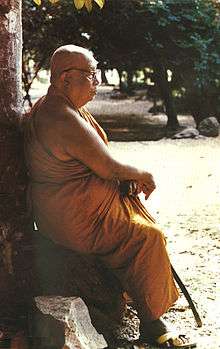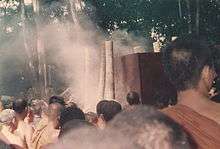Buddhadasa
| Phra Dharmakosacarya (Nguam Indapañño) "Buddhadasa Bhikkhu" | |
|---|---|
 | |
| Religion | Buddhism |
| School | Theravada, Maha Nikaya |
| Other names | Buddhadasa |
| Dharma names | Indapañño |
| Personal | |
| Nationality | Thai |
| Born |
May 27, 1906 Phumriang, Chaiya, Chaiya Province (now Surat Thani Province), Thailand |
| Died |
May 25, 1993 (aged 86) Wat Thannamlai, Chaiya District, Surat Thani Province, Thailand |
| Senior posting | |
| Title |
Phra Khru Indapaññacariya (1946) Phra Ariyanandamuni (1950) Phra Rajajayakavi (1957) Phra Debvisuddhimedhi (1971) Phra Dharmakosacarya (1987) |
Phra Dharmakosacarya (Nguam Indapañño) (Thai: พระธรรมโกศาจารย์ (เงื่อม อินฺทปญฺโญ); rtgs: Phra Thammakosachan (Ngueam Inthapanyo)), also known as Buddhadasa Bhikkhu (Thai: พุทธทาสภิกขุ; rtgs: Phutthathat Phikkhu, May 27, 1906 – May 25, 1993) was a famous and influential ascetic-philosopher of the 20th century. Known as an innovative reinterpreter of Buddhist doctrine and Thai folk beliefs, Buddhadasa fostered a reformation in conventional religious perceptions in his home country, Thailand, as well as abroad. Although he was a formally a bhikkhu or "monk", having at the age of twenty years submitted to mandatory traditional religious controls, Buddhadasa developed a personal view that rejected specific religious identification and considered all faiths as principally one. His groundbreaking thought inspired such persons as the French schooled Pridi Banomyong, leader of the Siamese revolution of 1932, and a group of Thai social activists and artists of the 1960s and 70s.
Early years
He was born Nguam Phanit (Thai: เงื่อม พานิช; rtgs: Ngueam Phanit) in 1906 in Ban Phumriang, Chaiya District, southern Thailand. His father, Sieng Phānit, was a shopkeeper of second generation Thai Chinese (Hokkien) ancestry and his mother, Klaun, was Thai.[1] He renounced civilian life in 1926. Typical of young monks during the time, he traveled to the capital, Bangkok, for doctrinal training but found the wats there dirty, crowded, and, most troubling to him, the sangha corrupt, "preoccupied with prestige, position, and comfort with little interest in the highest ideals of Buddhism."[2] As a result, he returned to his native rural district and occupied a forest tract near to his village. He named it Suan Mokkh from Thai สวน suan "garden" and Pali moksha "release, liberation".[3] He strove for a simple, pristine practice in attempt to emulate Gautama Buddha's core teaching, "Do good, avoid bad, and purify the mind." He therefore avoided the customary ritualism and internal politics that dominated Siamese clerical life. His ability to explain complex philosophical and religious ideas in his native Southern Thai attracted many people to his wooded retreat.
However, Buddhadasa was skeptical of his fame; when reflecting on the busloads of visitors to Suan Mokkh he would say, "sometimes I think many of these people just stop here because they have to visit the bathroom."[4]
Belief in "no religion"
From the earliest period of his religious studies, Buddhadasa utilized a comparative approach and sought to be able to explain "Buddhist's teachings through other thought systems such as Taoism, Hinduism, Confucianism, Jainism and Natural Science."[5] Through such a methodology he came to adopt a religious world-view that rejected exclusionary religious identification. In his No Religion (1993) Buddhadasa famously remarked, "in advanced perspectives there is no religious identification whatsoever."[6]
...those who have penetrated to the highest understanding will feel that the thing called 'religion' doesn't exist after all. There is no Buddhism; there is no Christianity; there is no Islam. How can they be the same or in conflict when they don't even exist?[7]
Religious scholar D.K. Swearer has compared Buddhadasa to the early Indian philosopher Nagarjuna.[8]
Wat Thannamlai

In 1932, Buddhadasa founded Suan Mokkh. His primary teaching mainly focused on the quiet awareness of one's breathing pattern called anapanasati. However, his personal practice was very much grounded in advanced research and interpretation of early Pali texts on the one hand and on his radical private experimentation on the other.
In later years, Buddhadasa's teachings attracted many international seekers to his hermitage. He held talks with leading scholars and clergy of various faiths. His aim in these discussions was to probe the similarities at the heart of each of the major world religions. Before his death in 1993, he established an International Dhamma Hermitage Center across the highway from his own retreat to aid in the teaching of Buddhism and other yogic practices to international students.
Works
Buddhadasa's works literally take up an entire room in the National Library of Thailand. The following are some of his well-known books in English translation.
- The A,B,Cs of Buddhism. 1982.
- Handbook for Mankind Buddhadasa's most well-known book.
- Heart-wood from the Bo Tree. Susan Usom Foundation, 1985.
- Keys to Natural Truth. Trans. R. Bucknell and Santikaro. N.d. First published 1988.
- Me and Mine: Selected Essays of Bhikkhu Buddhadasa (preview). Thēpwisutthimēthī, Buddhadasa, Swearer. SUNY Press, 1989.
- Mindfulness With Breathing. Trans. Santikaro. Second Edition. The Dhamma Study & Practice Group. 1989.
- No Religion. Trans. Punno, First electronic edition: September 1996.
- Paticcasamuppada: Practical Dependent Origination The Dhamma Study & Practice Group, 2002
- Teaching Dhamma with Pictures Published by Sathirakoses-Nagaparadi Foundation & Ministry of Education, Thailand On the occasion of the Centenary Celebration of the Bith of the Ven. Buddhadasa Bhikku(27 May 1906 - 27 May 2006)
Notes
- ↑ Suchira Payulpitack, Buddhadasa's Movement: An Analysis of Its Origins, Development, and Social Impact, a Doctorate dissertation, faculty of Sociology, Universität Bielefeld, 1992: 72-3.
- ↑ Payulpitack, 1992: 123.
- ↑ Moksha holds the sense of 'shedding ones skin.' See Harris, Moksha: an etymological note, Bauddhamata, 15.6.2009.
- ↑ Bhikkhu, Buddhadasa (1994). "Foreword". In Bhikkhu, Santikaro. Heartwood of the Bodhi Tree. Wisdom Publication. pp. ix. ISBN 0-86171-035-5.
- ↑ Payulpitack, 1992: 97.
- ↑ Harris, 2007.
- ↑ Buddhadasa, No Religion Archived March 20, 2013, at the Wayback Machine., trans. Punno, 1996.
- ↑ D.K. Swearer, Dhammic Socialism. Bangkok: Thai Inter-Religious Commission for Development, 1986: 14. Cited in Payulpitack, 1992: 103, n. 2.
Further reading
- Buddhadasa, Bhikku; Pramoj, M.R. Kukrit (2003). "How we should understand the dhamma", Chulalangkorn Journal of Buddhist Studies 2 (1), 139-157
- Ito, Tomomi (2012). Modern Thai Buddhism and Buddhadasa Bhikkhu: A Social History, Singapore: NUS Press. ISBN 9789971695729
- Jackson, Peter Anthony (1986). Buddhadasa and doctrinal modernisation in contemporary Thai Buddhism: a social and philosophical analysis, Thesis, Australian National University
- Preecha Changkhwanyuen (2003). "Dhammic Socialism Political Thought of Buddhadasa Bhikku", Chulalangkorn Journal of Buddhist Studies 2 (1), page 118
- Puntarigvivat, Tavivat (2003). "Buddhadasa Bhikkhu and Dhammic Socialism", The Chulalongkorn Journal of Buddhist Studies 2 (2), 189-207
External links
- Ajahn Buddhadasa. nalanda.org.br/
- Biography of Buddhadhasa on YouTube. Three-part video.
- buddhadasa.com. Thai-language site dedicated to Buddhadasa.
- Category:Buddhadasa Bhikkhu. A list of Buddhadasa's online work. dharmaweb.org
- Talks by Santikaro about Buddhadasa. Audio recording in four parts
- Wat Suan Mokkh. Buddhadasa's Hermitage